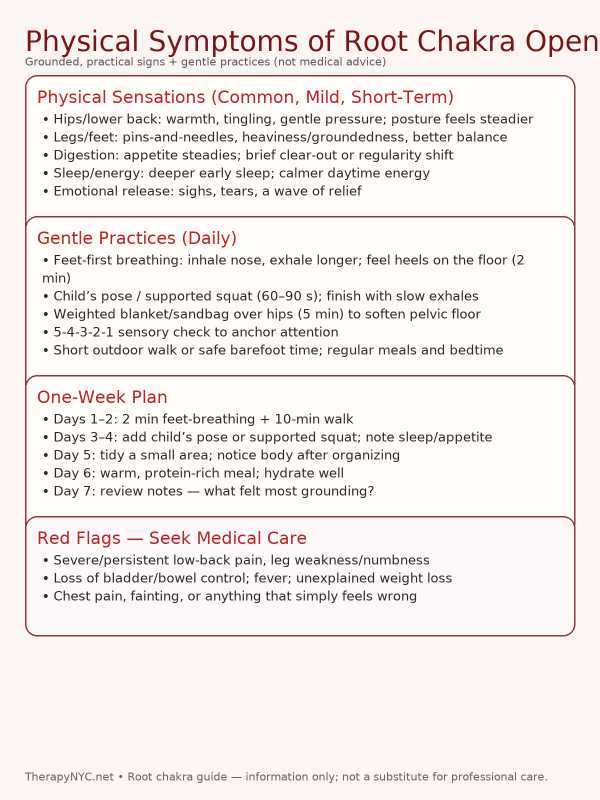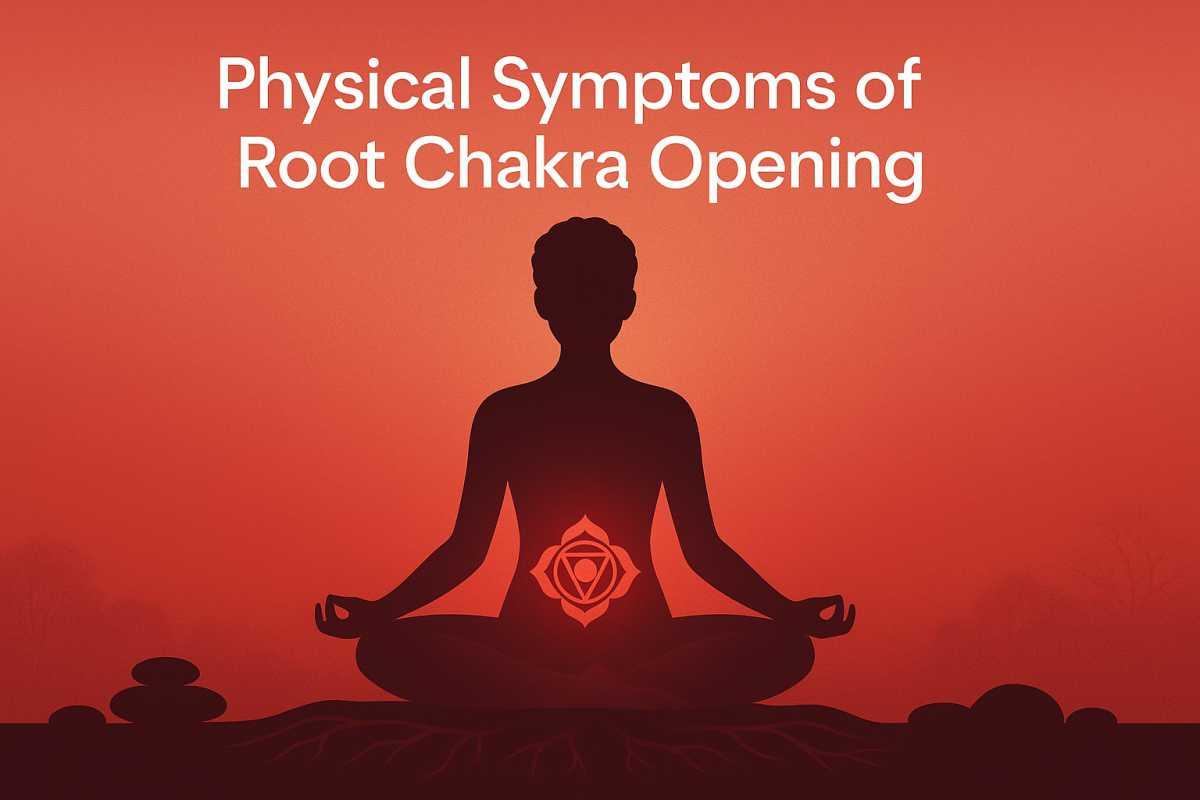Short Answer: When people describe a “root chakra opening” (Muladhara), they often report body sensations linked to grounding and safety—think heat, tingling, heaviness, or release around the hips, legs, feet, and lower back—plus shifts in appetite, sleep, and bathroom patterns. These can be temporary and mild. If anything is intense, persistent, or worrisome, get medical advice; chakra work is not a substitute for care.
What The Root Chakra Represents
In the chakra model, the root chakra (Muladhara) sits at the base of the spine and relates to safety, stability, and basic needs. People say that when this center becomes more balanced or “opens,” the nervous system moves from fight/flight back toward steadier ground. If the chakra language isn’t your style, you can read the sensations below as signs of nervous-system regulation and improved body awareness.
Why Physical Sensations Show Up
Attention = Sensation: Bringing focus to the pelvis, hips, and feet makes you notice subtle signals that were already there.
Tension Release: Breathwork, grounding, or slow yoga can relax long-held muscle guarding, leading to warmth, pulsing, or twitching.
Routine Changes: New practices (sleep, food, caffeine, movement) naturally shift energy and digestion, which you may attribute to chakra work.
Related Article: Chakra Healing Meditation
Common Physical Signs People Report
Not everyone feels all of these, and they don’t prove anything mystical; they’re simply typical, short-term experiences people describe:
1) Hips, Pelvic Floor, And Lower Back
Warmth, tingling, or gentle pressure near the tailbone/sacrum
Heaviness or groundedness in the hips and thighs
Spontaneous stretching or yawning as muscles let go
Posture changes—standing taller, more weight through the heels
2) Legs And Feet
Pins-and-needles or buzz in calves and soles after grounding
Desire to walk barefoot or stand firmly; steadier balance
3) Appetite, Digestion, And Elimination
Appetite stabilizing or craving warm, dense foods
Bowel changes (slightly more regular or a brief “clear-out”)
Hydration cues becoming clearer (thirst, dry lips easing)
These should be mild and temporary. Ongoing constipation/diarrhea, blood in stool/urine, pelvic pain, or urinary problems deserve a medical check.
4) Sleep And Energy
Deeper early-night sleep or short afternoon dips as the body resets
More steady daytime energy; less frantic “wired but tired” feeling
5) Sensory And Emotional Grounding
Calmer startle response; easier to feel your feet on the floor
Safety cues standing out—locking doors, paying bills on time, tidy routines
Brief waves of emotion releasing (sighs, tears) followed by relief
Discomfort Vs. Red Flags
Usually okay: fleeting tingles, mild low-back warmth, temporary muscle soreness after new movement, slight shifts in appetite/sleep/bowels.
Stop and seek care if you notice severe or persistent lower-back pain, numbness/weakness in a leg, loss of bladder/bowel control, fever, unexplained weight loss, fainting, chest pain, or anything that simply doesn’t feel right. Trust your body.

Grounding Practices To Smooth The Process
Use one or two daily; consistency matters more than intensity.
Feet-First Breathing (2 minutes): Inhale through the nose, exhale longer than your inhale. While exhaling, lightly press your feet into the floor.
Low Squat Or Child’s Pose (60–90 seconds): Ease into it; focus on slow exhales.
Weighted Blanket Or Sandbag On Hips (5 minutes): Encourages pelvic floor release.
5-4-3-2-1 Sensory Check: Name five things you see, four you feel, three you hear, two you smell, one you taste—then breathe.
Routine Anchors: Regular meals, hydration, and bedtime; reduce late caffeine.
Outside Time: Brief barefoot grounding on safe surfaces or a slow 10-minute walk.
A Gentle One-Week Plan
Day 1–2: 5 minutes of feet-first breathing + short walk.
Day 3–4: Add child’s pose or supported squat; track sleep and appetite.
Day 5: Tidy a small area (root loves order); notice how your body feels after.
Day 6: Eat a warm, protein-rich meal; hydrate well.
Day 7: Review notes. Which practices made you feel heavier-in-a-good-way and calm?
Frequently Asked Questions
How Long Do Symptoms Last?
For most people the sensations are subtle and brief—minutes to a few days—appearing when you actively practice grounding and fading as your system stabilizes.
Can Root Work Trigger Anxiety?
Sometimes focusing inward surfaces stored tension first. Keep sessions short, lengthen your exhale, and finish with an external focus (cool water, fresh air). If anxiety spikes or interferes with life, talk to a qualified professional.
Is Pain Normal?
No persistent pain is “normal.” Mild soreness from new movement can happen; sharp, radiating, or lasting pain needs assessment.
Quick Symptom Tracker (Copy/Paste Into Notes)
Sensations (hips/legs/feet, warmth/tingle/pressure):
Sleep (hours, quality):
Appetite/digestion (any change?):
Mood & safety behaviors (calmer? organized?):
Practices done today (breath, pose, walk, other):
Anything to check with a clinician:
Bottom Line
“Physical symptoms of root chakra opening” are best understood as your body noticing and releasing. Look for grounded legs, relaxed hips, steadier sleep, and clearer hunger/thirst cues. Keep practices gentle and consistent, pair them with real-world safety (budget, boundaries, tidy space), and see a healthcare professional for anything intense, persistent, or simply worrying.
